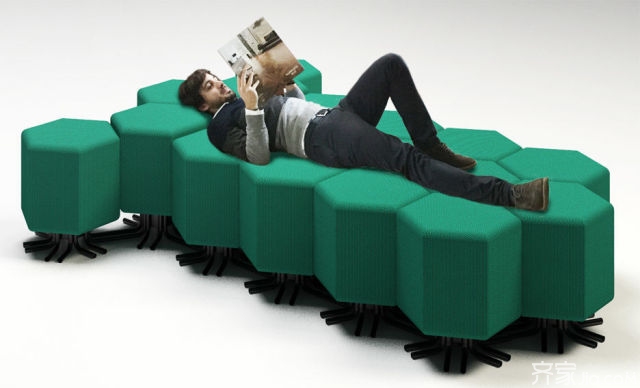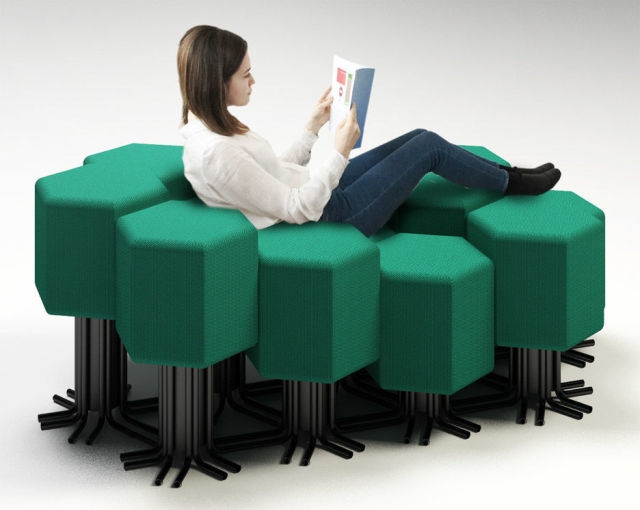 The Milan Furniture Fair 2016 is about to open next week. The big brand Vitra of the furniture industry is planning to release a revolutionary intelligent adjustable sofa LiftBit. At the helm is the Italian architect Carlo Ratti. Carlo Ratti sees it as a furniture system and claims to be the world's first sofa to use the Internet of Things concept. In an interview with Dezeen, he said: "At this year's Milan Design Week, we will really explore how the Internet of Things enters our home life."
The Milan Furniture Fair 2016 is about to open next week. The big brand Vitra of the furniture industry is planning to release a revolutionary intelligent adjustable sofa LiftBit. At the helm is the Italian architect Carlo Ratti. Carlo Ratti sees it as a furniture system and claims to be the world's first sofa to use the Internet of Things concept. In an interview with Dezeen, he said: "At this year's Milan Design Week, we will really explore how the Internet of Things enters our home life."  LiftBit is also a bold attempt. It is a modular, liftable hexagon seat that can be used alone or in any combination. The number depends on the needs of your scene.
LiftBit is also a bold attempt. It is a modular, liftable hexagon seat that can be used alone or in any combination. The number depends on the needs of your scene. 
 What's more, it has a matching mobile phone application. In the case of a Wi-Fi network connection, the position of each seat can be changed by the mobile phone, and it can be raised as a handrail or a backrest, and each module can be modularized. The number of seats, the position of the seats, and the lifting conditions determine whether it is a chair, a sofa or a bed.
What's more, it has a matching mobile phone application. In the case of a Wi-Fi network connection, the position of each seat can be changed by the mobile phone, and it can be raised as a handrail or a backrest, and each module can be modularized. The number of seats, the position of the seats, and the lifting conditions determine whether it is a chair, a sofa or a bed. 

Sofa home design
Often colloquially referred to as the brand name Homset – save contractors valuable time by using .22 to .27 caliber loads to drive fasteners into tough materials, like concrete and steel. But with prices ranging from under $40 to over $400, picking the right one can be tough.
Nail guns use fasteners mounted in long clips (similar to a stick of staples) or collated in a paper or plastic carrier, depending on the design of the nailgun. Some full head nail guns, especially those used for pallet making and roofing, use long plastic or wire collated coils. Some strip nailers use a clipped head so the nails can be closer together, which allows less frequent reloading. Clip head nails are sometimes banned by state or local building codes. Full Round Head nails and ring shank nails provide greater resistance to pull out. Nailers may also be of the 'coil' type where the fasteners come in wire or plastic collation, to be used with nail guns with a drum magazine; the advantage is many more fasteners per load, but at the expense of extra weight. Industrial nailers designed for use against steel or concrete may have a self-loading action for the explosive caps, but most need nails to be loaded by hand. Nail guns vary in the length and gauge (thickness) of nails they can drive.
Air compressor supplies air into a nail gun
The smallest size of fasteners are normally 23 gauge (0.025 inches in diameter), commonly called "pin nailers" and generally having no head. They are used for attaching everything from beadings, mouldings and so forth to furniture all the way up to medium-sized (7 to 8 inch) baseboard, crown molding and casing. Lengths are normally in the range ⅜ to 1¼ in. (10 to 32 mm), although some industrial tool manufacturers supply up to 2 in. (50 mm). The 23 gauge micro pin is rapidly gaining ground as users find that it leaves a much smaller hole than brad nails, thereby eliminating the time normally taken to fill holes and presenting a far better looking finished product.
The next size up is the 18 gauge (1.02 mm diameter) fixing, often referred to as a "brad nail". These fastenings are also used to fix mouldings but can be used in the same way as the smaller 22 to 24 gauge fastenings. Their greater strength leads to their use in trim carpentry on hardwoods where some hole filling is acceptable. Most 18 gauge brads have heads, but some manufacturers offer headless fastenings. Lengths range from â… in to 2 in. (16 mm to 50 mm)
The next sizes are 16 and 15 gauge (1.63 and 1.83 mm diameter). These are generally referred to as "finish nails". They come in lengths between â… and 2½ in. (16 to 64 mm) and are used in the general fixing of much softwood and MDF trim work (such as baseboard/skirtings, architraves, etc.) where the holes will be filled and the work painted afterwards.
The largest sizes of conventional collated fastenings are the clipped head and full head nails which are used in framing, fencing and other forms of structural and exterior work. These nails generally have a shank diameter of 0.11 to 0.13 in. (2.9 to 3.1 mm) although some manufacturers offer smaller diameter nails as well. General lengths are in the range 2 in to 3 1â„3 in (50 to 90 mm). Shank styles include plain, ring annular, twisted, etc. and a variety of materials and finishes are offered including plain steel, galvanized steel, sherardised steel, stainless steel, etc. depending on the pull-out resistance, corrosion resistance, etc. required for the given application. These sizes of fastenings are available in stick collated form (often 20° to 21° for full head, 28° to 34° for clipped head) or coil form (for use in pallet/roofing nailers) depending on the application. Full-head nails have greater pull-out resistance than clipped head nails[citation needed] and are mandated by code in many hurricane zones for structural framing.
Another type of fastening commonly found in construction is the strap fastening which is roughly analogous to the large head clout nail. These are used in conjunction with a strap shot nailer (or positive placement nailer UK) to fix metalwork such as joist hangers, corner plates, strengthening straps, etc. to timber structures. They differ from conventional nailers in that the point of the fastening is not sheathed so it can be exactly positioned before firing the nail gun.
Other specialist nailers are also available which can drive spikes up to 6¼ inches long, fix wood to steel, etc.
A variation on the nail gun is the palm nailer, which is a lightweight handheld pneumatic nailer that straps to the hand. It is convenient for working in tight spaces where a conventional nailer will not fit and is flexible enough to drive either short nails into metal straps or six inch nails into timber. By repeated hammer action (of around 40 hits per second) the fastener is driven into the material by a more constant palm pressure (as opposed to a conventional nailgun which drives the nail against the inertia of the nailgun).
10-shot Pin Nailer Fastening Tools,Galvanized Common Nails Manufacturers China,Powder Actuated Fasteners,Head Drive Pin with Top Hat
Yibin Heheng Technology Co.,Ltd , https://www.chinadirectfastening.com
